
Sai Baba of Shirdi, also known as Shirdi Sai Baba, was an Indian spiritual master and fakir, considered to be a saint, revered by both Hindu and Muslim devotees during and after his lifetime.

Dattatreya, Dattā or Dattaguru, is a paradigmatic Sannyasi (monk) and one of the lords of yoga, venerated as a Hindu god. He is considered to be an avatar and combined form of the three Hindu gods Brahma, Vishnu, and Shiva, who are also collectively known as the Trimurti, and as the manifestation of Parabrahma, the supreme being, in texts such as the Bhagavata Purana, the Markandeya Purana, and the Brahmanda Purana, though stories about his birth and origin vary from text to text. Several Upanishads are dedicated to him, as are texts of the Vedanta-Yoga tradition in Hinduism. One of the most important texts of Hinduism, namely Avadhuta Gita is attributed to Dattatreya. Over time, Dattatreya has inspired many monastic movements in Shaivism, Vaishnavism, and Shaktism, particularly in the Deccan region of India, Maharashtra, Gujarat, Madhya Pradesh, Rajasthan and Himalayan regions where Shaivism is prevalent. His pursuit of simple life, kindness to all, sharing of his knowledge and the meaning of life during his travels is reverentially mentioned in the poems by Tukaram, a saint-poet of the Bhakti movement.

Baba Ramdev (or Ramdevji, or Ramdeo Pir, Ramsha Pir is a Hindu deity of Gujarat and Rajasthan, India. He was a fourteenth-century Rajput ruler of Pokhran region who was said to have miraculous powers and devoted his life to uplifting the downtrodden and poor people. In Rajasthan, people of Meghwanshi or Meghwal community are called Rikhiya. Who are considered to be staunch devotees of Baba Ramdev, they have special rights to worship baba Ramdev and many other social groups in India worship him as Ishta-deva. He is considered as an avatar of the god Krishna.

Matsyendranātha, also known as Matsyendra, Macchindranāth, Mīnanātha and Minapa was a saint and yogi in a number of Buddhist and Hindu traditions. He is considered the revivalist of hatha yoga as well as the author of some of its earliest texts. He is also seen as the founder of the natha sampradaya, having received the teachings from Shiva. He is associated with Kaula Shaivism. He is also one of the eighty-four mahasiddhas and considered the guru of Gorakshanath, another known figure in early hatha yoga. He is revered by both Hindus and Buddhists and is sometimes regarded as an incarnation of Avalokiteśvara.

Upasani Maharaj, born Kashinath Govindrao Upasni, was an Indian spiritual teacher, considered by his disciples to be a satguru. He lived in Sakori, British India, and is said to have received God-realization from Sai Baba of Shirdi. Upasani himself was one of the principal masters of Meher Baba.
Humnabad is a city and municipal council in the Bidar District of the Indian state of Karnataka. Humnabad is the headquarters of Humnabad taluk.It is famous for The Veerabhadreswar Temple.It is at the center of Bidar and Kalaburgi District.It is at a distance of 60km from both the districts.It is well connected by roadways and railway network.It is connected by two national Highways NH-50 & NH-65.

Sripada Srivallabha is an Indian guru of the Dattatreya Sampradaya (Lineage) who is regarded as an incarnation of Lord Dattatreya. He is considered as one of the first complete Avatars (incarnations) of the deity Dattatreya in Kali Yuga. Of note, Narasimha Saraswati, Manik Prabhu, Swami Samarth, Sai Baba of Shirdi, are believed to be other incarnations of Lord Dattatreya that followed Sripada Srivallabha.
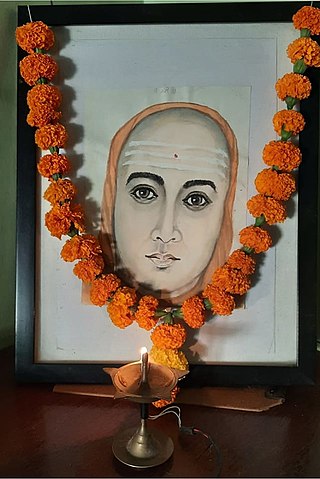
Shree Narasimha Saraswati Swami or Shree Nrusimha Saraswati Swami was an Indian guru of Dattatreya tradition(sampradaya). According to the Shri GuruCharitra, he is the second avatar of Dattatreya in Kali Yuga after Sripada Sri Vallabha.

Shri Swami Samarth Maharaj also known as Swami of Akkalkot was an Indian-Marathi saint of the Dattatreya Tradition. He is a known spiritual figure in various Indian states including Karnataka and Maharashtra. He lived during the nineteenth century from 1858 to1878.
The Chitrapur Guru Parampara or Guru Heritage of the Chitrāpur Sāraswat Brahmins is the lineage of spiritual teachers (gurus), also known as Mathadhipatis who have led the community throughout its history.
Swami Shankarāshram II was the fourth head guru or Mathādhipati of the Chitrapur Saraswat Brahmin community. He reigned from 1770 to 1785.
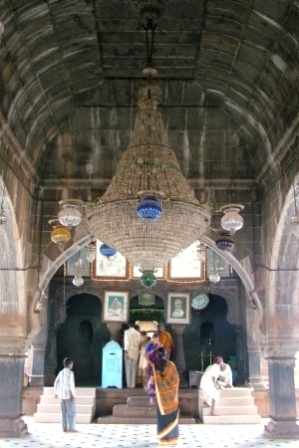
Maniknagar is a village located 3.5 kilometres (2.2 mi) away from Humnabad city in Bidar district in the Indian state of Karnataka. Maniknagar is a little village comprising a hamlet and a temple complex, the nucleus of which is the main temple of Manik Prabhu's Samadhi. Maniknagar is situated on the slopes of high ground near the holy confluence of two little rivulets Guru-Ganga and Viraja. The climate is by and large temperate.
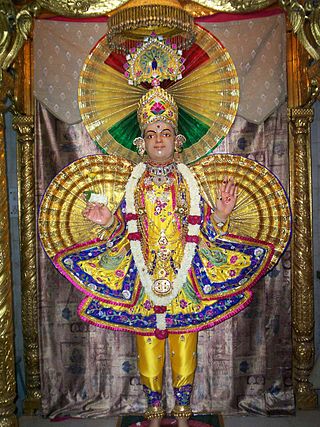
The Nar Narayan Dev Gadi, named after the two forms of supreme lord Nara-Narayana, is one of the two Gadis (seats) that together form the Swaminarayan Sampradaya. Its headquarter is at the Swaminarayan Temple, Ahmedabad and controls the Uttar Vibhag.

The Swaminarayan Sampradaya, also known as Swaminarayan Hinduism and Swaminarayan movement, is a Hindu Vaishnava sampradaya rooted in Ramanuja's Vishishtadvaita, characterized by the worship of its charismatic founder Sahajanand Swami, better known as Swaminarayan (1781–1830), as an avatar of Krishna or as the highest manifestation of Purushottam, the supreme God. According to the tradition's lore, both the religious group and Sahajanand Swami became known as Swaminarayan after the Swaminarayan mantra, which is a compound of two Sanskrit words, swami and Narayan.
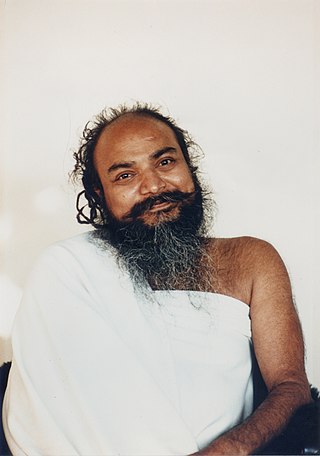
Shri Shivabalayogi Maharaj was a yogi who claimed to have attained self-realization through twelve years of arduous tapas, meditating in samādhi for an average of twenty hours a day.

Shivarudra Balayogi Maharaj, born Srinivas (Seenu) Dikshitar in Kolar in the South Indian state of Karnataka, is a self realised Yogi and a direct disciple of Shivabalayogi.

Swami Nigamananda Paramahansa was an Indian yogi, guru and mystic in Eastern India. He is associated with the Shakta tradition and a spiritual master of vedanta, tantra, yoga and prema or bhakti. His followers referred him as Thakura.

Bijoy Krishna Goswami, also known by the honorific Gosaiji, was a Hindu social reformer and religious figure in India during the British period.

Datta Jayanti, also known as Dattatreya Jayanti, is a Hindu festival, commemorating the birth of the Hindu deity Dattatreya (Datta), a combined form of the Hindu male divine trinity of Brahma, Vishnu, and Shiva.
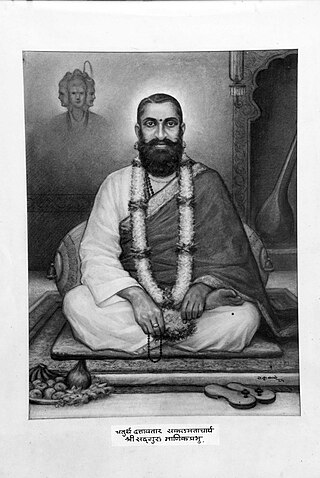
Manik Prabhu Maharaj was an Indian Hindu saint, philosopher, poet and guru. He is also regarded as an incarnation of Dattatreya by the people of Datta Sampraday. Prabhu's philosophy, the Sakala mata Siddhanta rests on the principles of Advaita Vedanta as propagated by Adi Sankara. Shri Prabhu strongly advocated the essential oneness of all religions. Prabhu's Muslim devotees revered him as an incarnation of Mehboob Subhani whereas his Lingayat devotees saw him as a form of Basavanna. Shri Prabhu composed numerous bhajans and padas in various languages such as Marathi, Kannada, Hindi, Urdu and Sanskrit. Shri Prabhu was also associated with the First War of Indian Independence in 1857. Shri Sai Baba of Shirdi, Shri Swami Samarth of Akkalkot, Shri Bramhachaitanya of Gondavale and many other contemporary saints are believed to have visited Maniknagar to interact with Prabhu on matters of deep spiritual wisdom. Biographers refer to Shri Prabhu as a saint of great spirituality and mysticism. Shri Prabhu's teachings emphasize the path of Bhakti. He also moralized on the vedantic truths concerning the spiritual unity of beings. Manik Nagar, Humnabad, Bidar District is the place where he took sanjeevani samadhi. Shri Prabhu's samadhi at Maniknagar is the nucleus of Manik Nagar and acts as the spiritual center of the activities of Shri Manik Prabhu Samsthan.




















